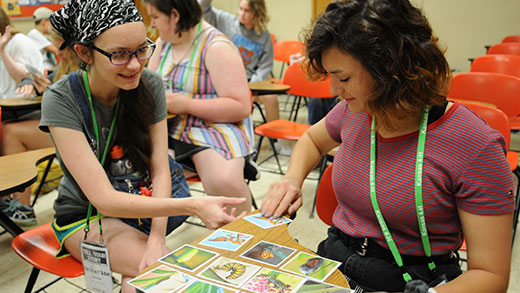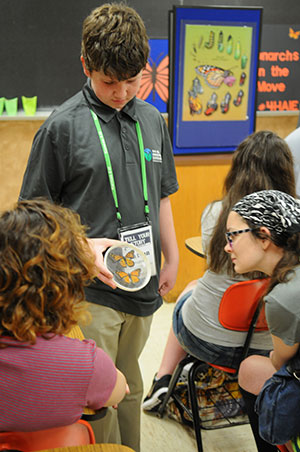
Kansas 4-Hers recently got a lesson on the difficult road to life for monarch butterflies during a Discovery Days class in late May. Twenty-two Kansas 4-Hers have begun an effort to preserve habitat that is critical for the survival of the monarch butterfly, in hopes of keeping it from becoming an endangered species. | Download this photo.
Kansas kids initiate effort to protect monarch butterfly
4-Hers working to preserve habitat for the iconic insect
June 7, 2018
MANHATTAN, Kan. – Nearly two dozen Kansas kids are stepping up to increase the odds of survival for the monarch butterfly, an iconic insect that is fluttering toward becoming an endangered species.
As of late May, they’d already taught lessons to nearly 1,000 other kids and even some adults on the best ways to build a habitat in which monarch butterflies can thrive.
“This is a conservation project to help the butterflies,” said 17-year-old Brett Droegemeier, a senior at Hays High School.
According to the U.S.-based Center for Biological Diversity, there were an estimated 682 million of the bright orange-and-black butterflies in North America in 1997. Last year, the same report noted the monarch population is down to 109 million.
The decline in monarch butterfly numbers led several groups to petition the U.S. Fish and Wildlife Service to protect the butterfly as threatened under the Endangered Species Act. The agency will make a ruling on the petition in June 2019.
Twenty-two 4-H’ers in Ellis and Barton counties aren’t content to wait for that to happen.
Fueled by a $20,000 grant from the National 4-H Council, they are teaching a class called “Monarchs on the Move” to youths and others in their communities, encouraging them to plant and preserve milkweed – the major food source and breeding ground for monarch butterflies.
“They have been out in after-school sites and classrooms and libraries doing this,” said Susan Schlichting, the 4-H youth development agent in Ellis County. “They see how excited the kids get and how dedicated to preserving the monarchs the younger kids are. I think that has built the energy among our teen team, as well.”
There are more than 100 varieties of milkweed, but many farmers, homeowners and landscape professionals consider it a weed to be sprayed, pulled or mowed. Doing so may be prudent for growing food or improving a landscape, but it’s a disaster for monarch butterflies.
That’s because female monarchs will only lay their eggs on milkweed, as many as 500 eggs at a time. And the caterpillars that spawn from those eggs will only eat milkweed.
Most of the caterpillars won’t become butterflies. It’s thought that only 1 in 20 (5 percent) will make it to adulthood, due to such factors as heat, cold, wind, rainstorms, predators, or the weed being sprayed, pulled or mowed while the caterpillars are trying to feed.
As 15-year-old Lexi Straub puts it, “it’s not easy to become a monarch butterfly.
“Monarchs are just such a unique species of butterfly, and it’s something we want to keep around for future generations,” said Straub, who is from Ellinwood and is one of the 22 youths who are teaching “Monarchs on the Move.” “I think it’s important for more generations to come to have the same experience of enjoying this butterfly.”
Berny Unruh, a 4-H youth development agent in Barton County, said “Monarchs on the Move” is a national curriculum that covers the biology of the monarch butterfly, as well as its migration pattern, life cycle and benefits to the ecosystem.
At the end of the hour-long class, kids plant their own milkweed that they are encouraged to take and re-plant in their backyard.
“It’s been really neat to see the younger kids listening to the teenagers and going, ‘yes, we should take these home and we should take care of these plants and make sure there’s food for the caterpillars and we also need to make sure these flowers are growing nectar for our butterflies to continue on,’” Unruh said. “Hopefully because of efforts like this, the numbers of monarch butterflies will increase.”
Kansas was one of just five states that received the $20,000 grant from the National 4-H Council, which was able to provide the money in partnership with Monsanto, Inc. Those states are located primarily in the Midwest, which is a key pathway as monarch butterflies migrate from Mexico to Canada in the spring, and back again in the fall.
“A few years ago, there was a freeze in Mexico, and we almost lost the population; only a very few of them survived,” Droegemeier said. “Hopefully with what we are doing and what other organizations are doing, their population is starting to increase again. We are hopefully getting them out of being endangered.”
Droegemeier is involved in a project to put several hundred milkweed plants in an outdoor classroom at Hays High School. The group of teens recently spoke to their peers at the annual 4-H Discovery Days event in Manhattan, and this summer they will present “Monarchs on the Move” during the Kansas 4-H Insect Spectacular at the Sedgwick County Zoo in Wichita, among other speaking engagements.
“For the teens, this program is huge because they have the opportunity to stretch their leadership abilities,” Schlichting said. “Most of them are young leaders and this is their first chance to put together a program. They’ve worked together in teams to design a program and present it in schools and after-school sites.
“There are many skills that they are gaining through this process. It’s been fun to watch the confidence that they’ve gained.”
To learn more about Monarchs on the Move, visit www.extension.iastate.edu/4h/monarchs-move.


